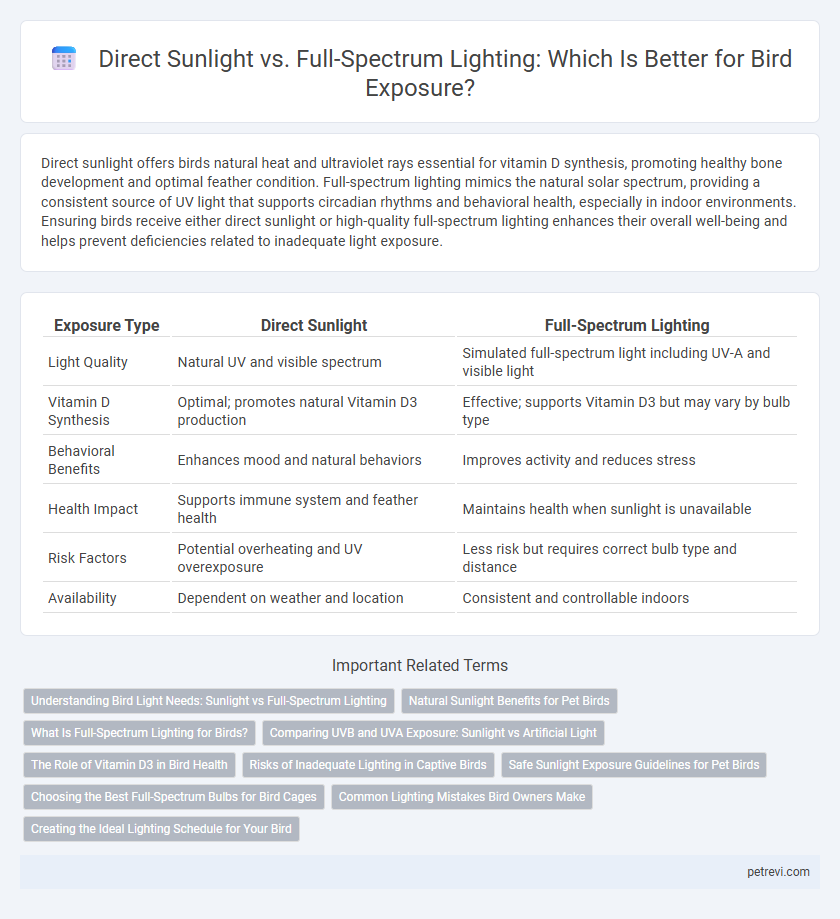Direct sunlight offers birds natural heat and ultraviolet rays essential for vitamin D synthesis, promoting healthy bone development and optimal feather condition. Full-spectrum lighting mimics the natural solar spectrum, providing a consistent source of UV light that supports circadian rhythms and behavioral health, especially in indoor environments. Ensuring birds receive either direct sunlight or high-quality full-spectrum lighting enhances their overall well-being and helps prevent deficiencies related to inadequate light exposure.
Table of Comparison
| Exposure Type | Direct Sunlight | Full-Spectrum Lighting |
|---|---|---|
| Light Quality | Natural UV and visible spectrum | Simulated full-spectrum light including UV-A and visible light |
| Vitamin D Synthesis | Optimal; promotes natural Vitamin D3 production | Effective; supports Vitamin D3 but may vary by bulb type |
| Behavioral Benefits | Enhances mood and natural behaviors | Improves activity and reduces stress |
| Health Impact | Supports immune system and feather health | Maintains health when sunlight is unavailable |
| Risk Factors | Potential overheating and UV overexposure | Less risk but requires correct bulb type and distance |
| Availability | Dependent on weather and location | Consistent and controllable indoors |
Understanding Bird Light Needs: Sunlight vs Full-Spectrum Lighting
Birds require exposure to natural sunlight or full-spectrum lighting to maintain optimal health and behavior. Direct sunlight provides essential ultraviolet (UV) rays that help synthesize vitamin D3, crucial for calcium absorption and bone strength. Full-spectrum lighting mimics the sun's natural light spectrum, supporting circadian rhythms, feather coloration, and overall well-being in indoor environments lacking sufficient sunlight exposure.
Natural Sunlight Benefits for Pet Birds
Natural sunlight provides pet birds with essential UVB rays that support vitamin D3 synthesis, crucial for calcium absorption and bone health. Full-spectrum lighting mimics the sun's rays but often lacks the intensity and spectrum variation necessary for optimal feather coloration and natural behaviors. Direct sunlight exposure promotes a healthy circadian rhythm and enhances overall well-being by stimulating natural hormonal cycles in birds.
What Is Full-Spectrum Lighting for Birds?
Full-spectrum lighting for birds replicates natural sunlight by providing balanced wavelengths across the visible and ultraviolet spectrum essential for avian health and behavior. This type of lighting enhances feather coloration, supports vitamin D synthesis, and regulates circadian rhythms better than direct sunlight or standard artificial lights. Proper exposure to full-spectrum lighting improves birds' immune function, mood, and overall well-being in indoor environments.
Comparing UVB and UVA Exposure: Sunlight vs Artificial Light
Direct sunlight provides birds with natural UVB and UVA radiation essential for vitamin D3 synthesis and overall health, while full-spectrum lighting aims to mimic these wavelengths but often lacks the intensity and balance of natural exposure. UVB from sunlight is critical for calcium metabolism, preventing metabolic bone disease, whereas artificial lights frequently emit lower levels of UVB, necessitating careful selection and placement to ensure adequate exposure. UVA exposure from both sources influences avian behavior and vision, but sunlight offers a broader spectrum that supports natural activities and well-being more effectively than most artificial lighting systems.
The Role of Vitamin D3 in Bird Health
Vitamin D3 synthesis in birds is primarily stimulated by exposure to direct sunlight, which provides the ultraviolet B (UVB) rays necessary for metabolic activation of calcium and phosphorus absorption. Full-spectrum lighting attempts to mimic natural sunlight by emitting UVB wavelengths but often falls short of the intensity and wavelength range found in direct sunlight, potentially resulting in suboptimal Vitamin D3 levels. Maintaining balanced Vitamin D3 through proper light exposure is crucial for preventing metabolic bone disease and supporting overall immune function in avian species.
Risks of Inadequate Lighting in Captive Birds
Inadequate lighting in captive birds can lead to serious health issues such as feather plucking, weakened immune function, and impaired calcium metabolism. Direct sunlight provides natural UVB rays essential for vitamin D3 synthesis, preventing metabolic bone disease, while artificial full-spectrum lighting mimics these benefits but requires precise calibration to avoid insufficient exposure. Ensuring optimal light intensity and duration with UVB components is critical for maintaining avian biological rhythms and overall well-being in captivity.
Safe Sunlight Exposure Guidelines for Pet Birds
Safe sunlight exposure for pet birds involves providing access to direct sunlight in short durations, typically 15-30 minutes daily, to ensure natural vitamin D synthesis without risking overheating or feather damage. Full-spectrum lighting serves as an essential alternative, replicating UVB rays critical for calcium metabolism when natural sunlight is limited or unavailable. Monitoring temperature, avoiding prolonged exposure, and selecting bulbs designed specifically for avian species optimize health benefits while minimizing harmful effects.
Choosing the Best Full-Spectrum Bulbs for Bird Cages
Choosing full-spectrum bulbs for bird cages ensures optimal UV light exposure crucial for avian health, feather quality, and vitamin D synthesis. Direct sunlight provides natural UVA and UVB rays, but controlled full-spectrum lighting replicates these benefits indoors, preventing harmful overheating. Prioritize bulbs offering UVA and UVB rays with a color temperature around 5000K to 7000K for balanced light that supports birds' circadian rhythms and overall well-being.
Common Lighting Mistakes Bird Owners Make
Bird owners often mistakenly rely solely on direct sunlight, exposing birds to harmful UV rays that can cause overheating and stress. Full-spectrum lighting mimics natural sunlight more safely and supports essential vitamin D synthesis for healthy bone development and feather condition. Proper use of full-spectrum lighting ensures birds receive the benefits of UV exposure without the risks associated with unfiltered direct sunlight.
Creating the Ideal Lighting Schedule for Your Bird
Providing birds with a carefully balanced lighting schedule that combines direct sunlight and full-spectrum lighting supports their natural circadian rhythms and promotes optimal health. Direct sunlight delivers essential ultraviolet (UVB) rays necessary for vitamin D synthesis, while full-spectrum lighting mimics natural daylight indoors, encouraging healthy behavior and feather condition. Schedule exposure to direct sunlight during morning hours when UVB intensity is moderate, complemented by full-spectrum lighting throughout the day to create a consistent and beneficial environment conducive to your bird's well-being.
Direct sunlight vs Full-spectrum lighting for Bird exposure Infographic

 petrevi.com
petrevi.com